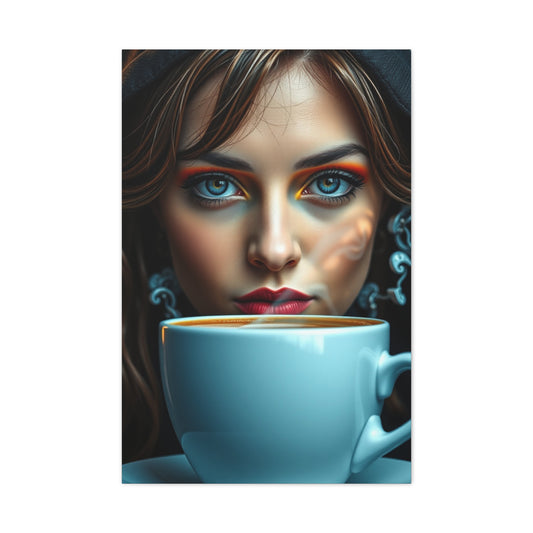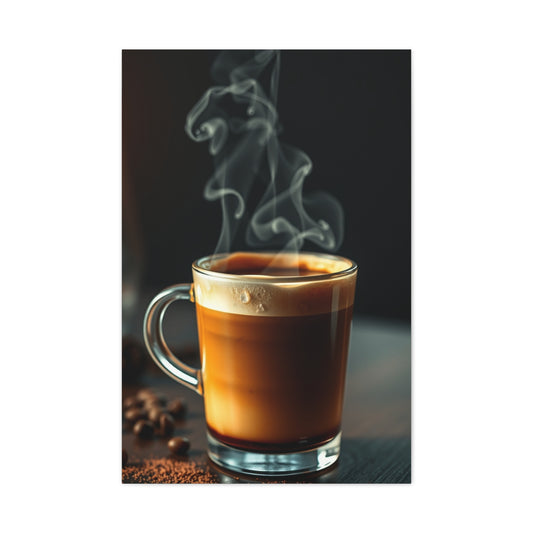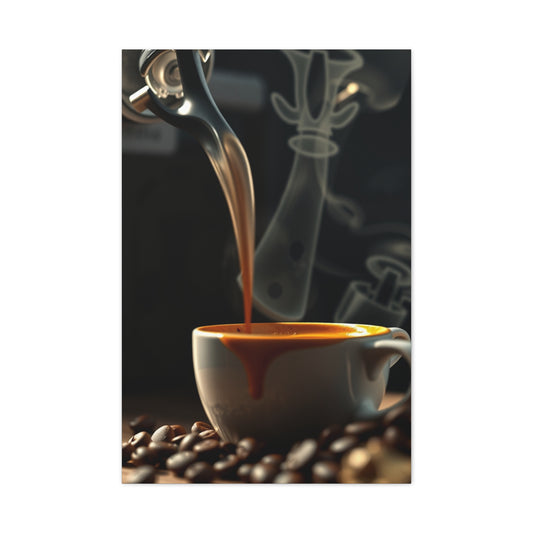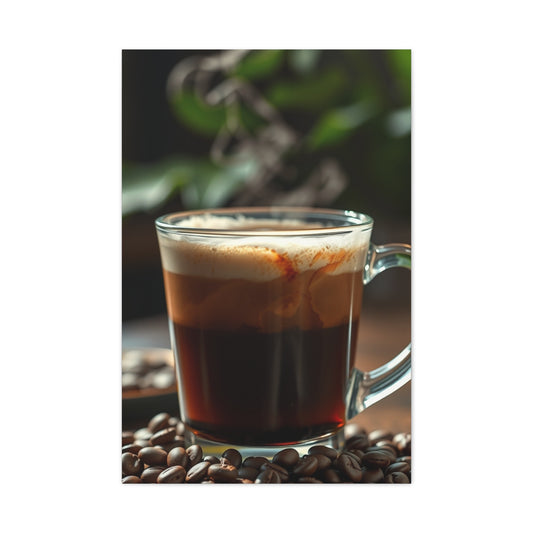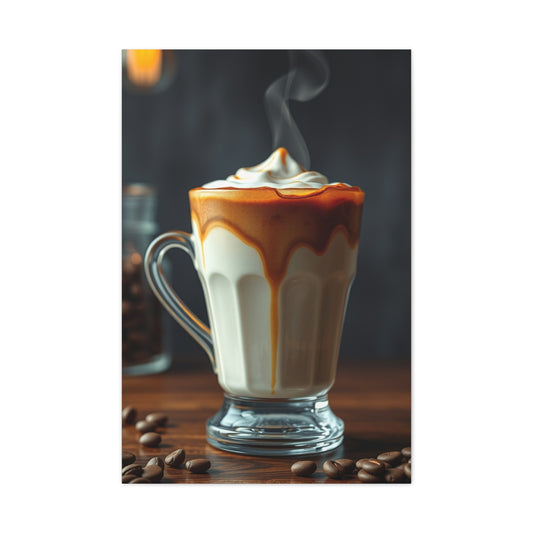In 2025, running a successful coffee shop means more than offering a great cup of coffee. Today’s customers seek experiences, not just products, and your interior design plays a pivotal role in shaping those experiences. A well-designed space can transform first-time visitors into loyal regulars. One of the most cost-effective and impactful ways to redefine your café’s ambiance is through intentional wall art. Art elevates the aesthetic of your space, communicates brand values, and makes your coffee shop more shareable across social platforms.
Establishing Elegance with Neutral Aesthetic Appeal
In contemporary interior design, especially within the realm of modern coffee shops, the allure of a neutral color palette has proven enduring and indispensable. These refined tones—beige, ivory, soft whites, taupe, and warm greys—exude an understated elegance, creating spaces that feel both tranquil and intentional. This palette does not impose itself; rather, it invites serenity and quietude into the environment. It establishes an atmosphere where every element, from textured surfaces to artisanal furnishings, can breathe and communicate subtly without overwhelming the visual narrative.
Neutral aesthetics are particularly suitable for coffee shops, which strive to foster moments of pause and reflection. The gentle contrast between a soft white wall and natural wood textures offers a sense of refined comfort. It’s a palette that speaks softly yet carries a deep sense of identity and sophistication. When neutrals are employed with meticulous attention, they transform interiors into serene canvases upon which light, materials, and curated details take center stage.
One of the most compelling complements to a neutral interior is wall art. Rather than acting as mere decoration, thoughtfully chosen artwork enhances spatial composition and serves as a conduit of personality. Within such minimalist frameworks, even the slightest visual addition can echo with significance. Whether it’s sepia-toned photography capturing a forgotten alleyway or a desaturated abstract piece rendered in charcoal and dusted ochre, artwork enhances dimensionality and introduces narrative depth.
Timeless and poised, these pieces bring coherence and balance to an otherwise restrained space. Art with earthy undertones or soft contrasts resonates effortlessly with contemporary furniture—think matte black metal frames, curved oak tabletops, or cane-backed chairs. The interplay between organic forms and subdued hues cultivates a setting of poetic stillness, ideal for patrons seeking both caffeine and contemplative calm.
Expressing Identity with Artistic Photography
Modern coffee shops are not just places to enjoy a cup of espresso; they are curated experiences—each establishment echoing the essence of its brand through design and ambiance. Among the many tools for establishing a strong interior identity, photographic art holds a distinguished place. When chosen with discernment, photography transcends decorative function and becomes an emblem of the café’s ethos.
|
Related Catagories: |
Photorealistic images—particularly those spotlighting the coffee-making process—capture the craft with reverence. Close-ups of freshly roasted beans, steaming brews mid-pour, or the gleam of a barista’s tamper frozen in motion evoke a tactile connection to the ritual of coffee. When rendered in monochrome or vintage tones, these visuals tap into a deeper sense of nostalgia and authenticity. They remind visitors that behind every espresso shot lies an art form rooted in heritage, skill, and intention.
Photography in a café context should be more than pretty pictures on a wall—it should serve as a visual echo of your narrative. Large-format pieces, thoughtfully mounted above communal tables or behind the espresso counter, create focal points that guide the customer’s eye. These compositions function as visual anchors, defining the rhythm and flow of the space. They also spark curiosity, potentially becoming conversation starters and memory triggers, ensuring your coffee shop leaves a lasting impression.
In smaller nooks, carefully selected diptychs or triptychs can create immersive visual stories. A triptych of minimalist black-and-white photographs showing different stages of latte creation—from grind to pour to crema—can subtly educate while beautifying. Even abstract photographic impressions, such as blurred street views or tonal studies of coffee stains, can carry layered meaning when positioned within a neutral interior.
Harmonizing Texture, Tone, and Art
In spaces steeped in neutral palettes, texture becomes paramount. The soft grain of untreated timber, the fibrous irregularity of linen seat cushions, the matte finish of ceramic mugs—each contributes to an immersive tactile experience. Art photography must converse fluently with these textures. A monochrome photograph with visible film grain may subtly mirror the coarseness of burlap coffee sacks or concrete flooring, creating harmony between wall and environment.
Additionally, frames play a pivotal role in the integration of art. Avoid glossy or overly ornate frames; instead, opt for walnut, ash, or brushed metal, all of which echo the honesty of material found throughout neutral-themed interiors. Float-mounting large pieces can also lend a contemporary edge, ensuring the artwork feels like an organic extension of the wall rather than an afterthought.
It's essential that the content of the photographic art speaks to both universal emotions and localized storytelling. Capturing scenes from nearby markets, local roasters, or even architectural fragments of the neighborhood can establish an authentic connection with patrons. Such images ground your brand in its geographical and cultural context while contributing to the broader aesthetic lexicon of the space.
Creating a Cohesive Visual Experience
Consistency in artistic direction is critical when striving for an immersive café design. From the light fixtures to the art on the walls, each visual element should belong to a shared universe. The artwork should not be a standalone feature but an integrated chapter within the café's overall narrative. Consider the mood you wish to convey—is it meditative, industrial-chic, rustic-modern, or subtly luxurious? Your photographic art should reflect that ethos with grace and cohesion.
Photography that resonates emotionally tends to outperform trendy graphics or overly literal illustrations. Customers engage more deeply with imagery that carries emotional weight or leaves space for interpretation. The quiet defiance in a vintage street portrait or the warmth of steam curling from a coffee cup can resonate more powerfully than vibrant or overstimulating visuals. These choices cultivate a mental and emotional atmosphere that patrons return to.
Transforming Walls into Brand Statements
Modern cafes are increasingly becoming lifestyle destinations, where design choices contribute to brand memorability. Your walls serve as prime real estate—not just for aesthetics but for storytelling and differentiation. Photography, particularly when curated with purpose and passion, transforms these walls into silent narrators of your brand journey.
Incorporating photography that subtly hints at your process, values, or origin story personalizes the space. For instance, a black-and-white portrait of your first barista or an atmospheric shot of the beans sourced from a local farm can bridge the emotional gap between consumer and creator. Such imagery humanizes your brand and invites loyalty.
Remember, the visual grammar of your café speaks volumes. Clients may not consciously register every design detail, but they will feel it. The arrangement of photographic art, the lighting that falls upon it, and the conversation it shares with your interiors all contribute to a subconscious brand impression—one that lingers longer than any marketing slogan.
The Quiet Power of Thoughtful Visuals
The intersection of neutral aesthetics and photography holds an enduring charm, especially in today’s overstimulated visual world. A minimalist coffee shop layered with compelling photography offers an oasis of clarity and coherence. It provides a curated pause in a culture that rarely stops. The calm rhythm of subdued tones paired with arresting visuals offers a holistic experience—one that is as much about what is absent as what is present.
In this balance lies the art of modern coffee shop design. By choosing photographic pieces that echo your ethos and harmonize with your palette, you transform your space from merely functional to meaningfully memorable. Every image, every texture, every hue becomes a brushstroke in the broader canvas of your brand—a quiet but eloquent declaration of elegance, intentionality, and story.
Creating Cohesion with Canvas Statements
In modern coffee shop design, canvas wall art offers a striking and sophisticated alternative to traditional framed prints or posters. Its clean lines, frameless presentation, and tactile appeal give it a refined yet accessible quality that integrates seamlessly into contemporary interiors. Unlike ornate frames or glossy paper prints, stretched canvas exudes a quiet elegance that feels organic and unpretentious.
Single-panel canvas pieces, especially those rendered in soft, neutral tones, make powerful focal points in an otherwise understated setting. Their visual weight helps ground the room without adding visual noise. By avoiding intricate frames and embracing raw, stretched edges, canvas art maintains a museum-grade aesthetic that still invites comfort and familiarity. Whether displayed above a leather banquette, near the entrance, or adjacent to a menu board, a single large canvas introduces structure and intentionality to the layout.
The versatility of canvas makes it an ideal medium for minimalist art, abstract impressions, or stylized photographic imagery. In particular, pieces that feature whispering lines, tonal gradients, or textural brushstrokes enhance the layered feel of a space while reinforcing a neutral, calming palette. These artworks speak softly but resonate deeply, supporting the visual narrative of your coffee shop without overwhelming it.
A carefully chosen canvas can also function as a spatial guide, drawing the eye toward key areas. By anchoring a seating zone or highlighting a transition point, these pieces contribute to the natural flow of movement throughout the café. They create visual punctuation without disrupting the harmony of the whole, reinforcing an atmosphere of ease and cohesion from the moment a customer enters.
Blending Modern Art with Natural Interiors
The intersection of modern design and nature-inspired materials creates a unique design language that resonates with today’s coffee culture. In spaces where minimalism reigns, introducing canvas wall art that mirrors organic textures or botanical motifs can offer a fresh and grounding contrast. Earth-toned compositions, muted geometric forms, and abstract interpretations of foliage harmonize beautifully with natural wood, raw stone, woven textiles, and lush greenery.
This synthesis fosters a mood that is both contemplative and comforting. Imagine a large neutral-toned canvas featuring textured botanical silhouettes hanging above a reclaimed wood bench. Adjacent to it, a fiddle leaf fig or cascading pothos adds vitality and dimension. The juxtaposition of canvas with verdant flora and tactile materials not only enhances aesthetic unity but also speaks to sustainability and timeless style—values that many modern cafés champion.
Velvet-upholstered seating in shades of olive, rust, or ochre further elevates the interplay between modern and natural design. Paired with wall art that mirrors these hues in subtle gradations, the overall environment becomes an enclave of warmth and tranquility. Mounting a neutral canvas on a paneled wood wall or surrounding it with woven baskets and artisanal ceramics adds layered interest without compromising minimalistic clarity.
This convergence of natural and modern aesthetics fosters a sense of grounded serenity. It invites guests to slow down, appreciate their surroundings, and fully immerse in the café's unique ambiance. In this way, the space becomes more than a stop for caffeine—it transforms into a curated experience, thoughtfully designed for both visual pleasure and emotional connection.
Enhancing Customer Comfort with a Soothing Palette
Color psychology plays a critical role in shaping the ambiance of any hospitality space, and coffee shops are no exception. The deliberate use of neutral wall art—whether in canvas, fabric, or framed form—can deeply influence how customers feel and behave. Soft hues such as sand, ecru, dove grey, and muted taupe evoke calm, focus, and composure, creating a serene oasis amid the commotion of everyday life.
Unlike high-contrast color schemes or overly vivid decor, a neutral palette facilitates a seamless sensory experience. It allows customers to engage with the space without visual strain, encouraging them to linger, reflect, and feel at ease. Neutral wall art acts as a calming backdrop that supports the primary function of the space—conversation, comfort, and community.
This is especially important in high-traffic coffee shops where diverse groups of people may be reading, working remotely, or meeting friends. Wall art rendered in soft, desaturated tones contributes to visual consistency while reducing fatigue and distraction. It subtly elevates the environment without demanding attention, aligning perfectly with the ethos of modern minimalism.
The mood created by neutral artwork is one of slow living and mindful engagement. Whether it’s a hazy landscape, an abstract pastel canvas, or a subdued photographic still life, these pieces contribute to an overall atmosphere of refinement and introspection. In doing so, they shape customer perception—not just of the space, but of the brand itself—as calm, thoughtful, and curated.
Using Wall Art to Guide Attention and Movement
Art is not merely decorative; it functions as a spatial tool that subtly directs perception and behavior. In well-designed cafés, wall art is deployed with strategic intent. A large-scale canvas behind the espresso counter can draw the eye and define the heart of the operation. Smaller pieces near window seating or along transitional zones help delineate areas, fostering a sense of intimacy or focus within an open-plan layout.
Wall art also emphasizes and elevates architectural features. A monochromatic abstract piece can accentuate the rhythmic repetition of arched doorways. An elongated canvas hung along an exposed brick wall brings texture into dialogue with form. These placements not only enhance aesthetic cohesion but also create memorable micro-environments within a single space.
Corridors or extended walls benefit from a gallery-style arrangement—perhaps a series of canvases in tonal progression or a collection of thematic photography. This visual rhythm breaks the monotony of long spaces and encourages movement while sustaining visual interest. In contrast, a solitary, oversized canvas at the end of a narrow hallway can act as a visual anchor, inviting visitors to explore further.
Careful placement of artwork near service areas can also improve functionality. For instance, subtle cues can guide customers toward self-service stations or seating sections, creating a sense of flow without the need for signage. Through thoughtful positioning, wall art enhances wayfinding and helps choreograph the guest experience in a way that feels organic and intuitive.
The Silent Elegance of Curated Wall Art
Canvas wall art, especially when chosen with purpose and positioned with care, becomes a silent yet eloquent storyteller. It shapes atmosphere, directs attention, and contributes to a cohesive brand identity without a single spoken word. In modern coffee shop interiors where every detail matters, wall art transcends decor and evolves into an integral element of the space’s soul.
Whether your aesthetic leans toward earthy modernism, rustic minimalism, or urban contemporary, there’s a canvas piece that can echo your values and elevate your environment. When blended with a palette of neutral hues, organic materials, and refined furnishings, canvas art reinforces a sophisticated yet welcoming tone. It invites customers to not only see the space—but to feel it.
Ultimately, it is this emotional resonance that sets memorable cafés apart. Beyond the coffee, beyond the layout, it is the mood—the calm, the warmth, the cohesion—that guests carry with them. Through the understated grace of canvas artwork, your coffee shop becomes not just a destination, but a sanctuary of style, comfort, and intention.
Building Brand Personality with Pop-Culture Inspiration
In the ever-evolving world of coffee shop culture, creating a memorable and magnetic interior experience has become as important as crafting the perfect espresso. For coffee shops that thrive on vibrancy, personality, and a sense of community, pop-culture-inspired wall art is a powerful way to build emotional resonance with patrons. These creative visuals go beyond mere decoration—they reflect identity, provoke nostalgia, and transform the café into a social epicenter.
Pop culture is a universal language. When guests see wall art referencing their favorite sitcoms, movie quotes, or musical icons, an instant sense of familiarity and joy emerges. These pieces, often saturated with visual storytelling and cultural cues, serve as subtle yet effective brand-builders. A widely beloved example is the Central Perk-style aesthetic, paying homage to the classic television show "Friends." Such artwork creates a comforting sense of belonging while positioning the café as a go-to place for connection and conversation.
This kind of design strategy doesn’t just enhance ambiance—it fuels interaction. Customers are more likely to take photos, tag locations on social platforms, and share their experience with others. In a digital era where word-of-mouth thrives online, pop-culture references become shareable assets. Whether it's a mural featuring vintage film characters or a canvas nodding to iconic gaming imagery, these artistic flourishes spark dialogue and reinforce your café's role as a contemporary cultural node.
Furthermore, pop-art-style visuals or graphic illustrations inspired by pop culture can lend the space a youthful, edgy tone. These bold stylistic choices resonate with Gen Z and millennial audiences, aligning your café with modern tastes without sacrificing warmth or authenticity. This interplay of cultural homage and visual excitement allows your interior to feel curated yet spontaneous—structured yet soulfully expressive.
Inviting Humor and Lightness with Quirky Quotes
While compelling visuals draw the eye, words often speak directly to the heart. Typography-based wall art has emerged as a signature element in modern cafés, combining style and sentiment in equal measure. By featuring witty coffee sayings, clever puns, or motivational quips, this form of artwork invites lighthearted engagement and reinforces the café’s personality as both playful and welcoming.
Quirky quote prints create moments of levity that resonate deeply with guests. Whether it’s a cheeky sign that reads “Espresso Yourself” or a playful affirmation like “Life happens, coffee helps,” these word-based artworks inspire grins, chuckles, and even snapshots. They’re perfect for placing above self-serve condiment stations, beside entryways, or along narrow hallways where vertical space invites smaller format designs.
This whimsical messaging contributes to an atmosphere of informality and approachability. It reminds customers that cafés aren’t just places to drink coffee—they’re environments where stress takes a backseat and simple pleasures are celebrated. These conversational pieces often become landmarks within the shop, serving as orientation points that visitors remember and talk about.
Additionally, when paired with carefully chosen typography styles—such as hand-lettered scripts, vintage typewriter fonts, or sleek modern sans-serifs—these prints double as both design and dialogue. The fusion of visual harmony and verbal cleverness supports your café’s tone of voice and strengthens its identity. Word art, especially when customized or locally inspired, also enhances brand distinctiveness. Imagine a regionally relevant phrase rendered in bold type or a locally famous quote transformed into a wall centerpiece—these choices root your business in its community while adding flair.
Energizing Interiors with Bold Colors and Abstract Forms
While neutral palettes and rustic minimalism have dominated the café design landscape, there’s an emerging movement toward more expressive, color-forward interiors. For coffee shops seeking to stand out and energize their environment, bold wall art infused with vivid colors and abstract compositions offers a dynamic design avenue. These works serve as a declaration of creativity and modernity, making the space unforgettable from the very first glance.
Color has an extraordinary capacity to evoke emotion. When hues like coral, teal, saffron, or Pantone’s color of the year—such as Viva Magenta—are infused into large-scale artworks, they inject vitality and dimension into the space. These vibrant compositions provide dramatic contrast against wood furnishings, white walls, or industrial fixtures, offering a jolt of visual stimulation that feels fresh and intentional.
Abstract art is particularly effective in energizing interiors because it allows for open interpretation. Swirling brushstrokes, asymmetrical forms, or layered geometric patterns speak to imagination and emotion rather than narrative. This quality makes them ideal for diverse customer bases, allowing each viewer to experience the art personally. In fast-paced urban settings or creative districts, such artwork positions your café as progressive and visually fluent.
Bold pieces work especially well in strategic zones—behind the espresso bar, in feature alcoves, or on full accent walls. A single large-format canvas in electrifying colors can act as the heartbeat of the interior, giving the café a sense of pulse and identity. For open layouts, this kind of art also helps define zones and encourage spatial flow without the use of physical dividers.
These design choices also signal inclusivity and individuality. By embracing bold tones and unconventional forms, you communicate that your coffee shop is a place of self-expression—a space that welcomes uniqueness and encourages customers to be themselves. This resonates powerfully with artists, creatives, and socially connected guests looking for more than just a caffeine fix.
|
Related Catagories: |
Blending Visual Impact with Strategic Branding
When executed thoughtfully, wall art becomes one of the most effective branding tools in your café. It enhances ambiance, tells your story, and connects emotionally with your audience. The combination of pop-culture references, witty phrases, and bold abstract forms can reflect the multi-dimensional nature of your brand—fun yet sophisticated, nostalgic yet forward-thinking.
Strategic placement is crucial. Pop-culture pieces should be located where they’re easily seen and appreciated—near communal tables, waiting zones, or corners where people gather and take photos. Typography prints thrive in transitional spaces where guests pause or pass by. Abstract art, on the other hand, commands larger, more open walls where its energy can radiate freely without visual competition.
Mixing different forms of wall art within a single cohesive theme creates a layered, immersive experience. You might have a pop-art portrait anchoring the main lounge, motivational word art in the restroom vestibule, and a sprawling abstract piece animating the back wall. This diversity, when curated well, keeps the space engaging and encourages patrons to explore every corner.
Finally, wall art can evolve with your brand. Rotating installations or limited-time pieces can reflect seasonal themes, collaborations with local artists, or responses to cultural moments. These changes keep your interior fresh and relevant, offering repeat visitors something new to enjoy and talk about.
Celebrating Artistic Contrast with Mixed Media Displays
A coffee shop is more than just a place to sip a cappuccino—it’s a cultural environment, a visual journey, and a social anchor. To elevate the customer experience beyond the beverage, thoughtful interior design is key. One compelling design approach that enriches the ambiance and introduces layered storytelling is the use of mixed media displays. By combining different artistic formats—photography, painting, illustration, and typography—a café's interior evolves from merely stylish to intricately curated.
Mixed media wall art captivates precisely because of its unpredictability. It breaks the monotony of uniform décor and allows visual contrasts to become focal points. For instance, pairing a minimalistic hand-drawn sketch with a bold, saturated canvas introduces a dance of visual tension and harmony. A classic movie poster juxtaposed beside a raw-edge abstract painting evokes eras, genres, and emotions that invite exploration and personal interpretation.
A popular tactic in contemporary café interiors is blending tactile elements to enhance spatial richness. Incorporating a neon sign above the register or coffee counter—perhaps a playful phrase or symbol—next to vintage travel posters or monochrome photography introduces temporal layers that appeal across generations. These contrasting yet cohesive visuals create what designers refer to as “emotive dissonance”—where difference generates interest and complexity rather than chaos.
The textural interplay of materials adds another dimension. Canvas wraps bring softness and subtle grain; acrylic prints offer crisp, high-definition gloss; metal or glass frames introduce a polished industrial aesthetic. These variations offer more than just visual interest—they invite touch and presence, creating an environment that feels deeply alive and physically immersive. Every surface tells a story, and every texture invites a different emotional response.
This eclectic presentation allows for storytelling that aligns with brand identity while avoiding the pitfalls of sterile, mass-produced decor. A mixed media wall installation becomes a living art piece that continues to evolve. It gives returning customers something new to notice and appreciate—a subtle shift in lighting on a metallic frame, or the way a neon sign glows differently at twilight. In essence, your wall art becomes an ever-changing conversation with your audience.
Fostering a Community Hub Through Shared Design
Cafés have long served as communal spaces—places where friends gather, freelancers work, and strangers strike up spontaneous conversations. Beyond the drinks and service, what truly fosters this sense of gathering is a space that feels inviting, personal, and meaningful. Wall art plays a central role in facilitating that ambiance, transforming static walls into storytellers of culture, locality, and shared identity.
Art that reflects the collective experiences of your target audience helps to cultivate emotional resonance. Nostalgic illustrations, locally themed photography, or humorous graphics can trigger instant recognition and connection. For instance, a piece of art referencing a beloved neighborhood landmark, local festival, or iconic saying can evoke a smile or spark a memory. These moments of recognition contribute to a feeling of rootedness—an acknowledgment that the space “gets” its patrons.
Typography-based prints that incorporate regional idioms or inside jokes create intimacy, as do comic-style panels illustrating daily life or coffee culture quirks. These accessible and relatable pieces become participatory—they invite interaction, laughter, and stories. Customers may stop to read a quote, comment on a clever illustration, or point out an image to their friends. The wall art thus becomes not only aesthetic, but social and interactive.
To deepen this sense of community and build ongoing engagement, many coffee shops are embracing the dynamic nature of rotating art installations. Seasonal refreshes or monthly themes not only keep the space visually engaging, but also allow customers to feel part of an evolving narrative. New displays can reflect seasonal flavors, cultural holidays, or current events—subtly reinforcing that your space is responsive, current, and alive.
One particularly impactful way to merge art with community is by showcasing work from local artists. Hosting exhibitions or providing wall space for emerging creatives supports the cultural ecosystem of your area while offering unique, locally resonant content. Patrons are often more emotionally invested in places that visibly support their neighborhood’s talent, and showcasing these works builds goodwill, brand integrity, and long-term customer affinity.
This localized curation can take many forms—photographic series capturing street scenes from nearby markets, portrait studies of local figures, or abstract interpretations of your city’s skyline. Collaborations with local schools, colleges, or art collectives create opportunities for cultural cross-pollination and even drive foot traffic from artist networks.
Designing Emotionally Intelligent Spaces
In the age of experience-driven consumer behavior, it’s not enough for a coffee shop to be visually attractive—it must feel emotionally intelligent. That is, the space should intuitively reflect and respond to the moods, desires, and personalities of its patrons. Wall art curated with empathy and cultural awareness helps to strike this delicate balance, offering not just beauty but belonging.
The interplay of mixed media and community storytelling creates interiors that are as emotionally textured as they are visually compelling. A watercolor painting of a bustling street corner, placed near a vibrant mural, creates a sense of rhythm that mirrors the dynamic lives of your guests. It reflects their diversity, their nostalgia, and their creativity.
Subtle choices such as including inclusive imagery—representations of people from varied backgrounds, body types, or lifestyles—further position your café as a safe and affirming space. Visual cues matter, and when customers see themselves reflected in your design, they’re more likely to return, recommend, and become regulars.
Even abstract or non-representational art can be used to evoke feelings that align with your brand ethos. Soft pastel gradients can imply serenity; bold brushwork may suggest energy or passion. When these pieces are layered into a mixed media collection, each contributes its own emotional timbre, creating a space that resonates on multiple levels.
Evolving With Purpose and Authenticity
One of the great strengths of a mixed media wall approach is its inherent flexibility. Unlike static décor, this model encourages adaptation and experimentation. You can add, remove, or reposition elements to reflect the seasons, your brand’s growth, or even the shifting mood of your customer base.
This fluidity allows you to keep the environment fresh without overhauling the entire design. You might introduce a new illustrated print every month, rotate artist spotlights quarterly, or adjust your layout to accommodate events or theme weeks. This keeps the space dynamic and gives customers something new to engage with over time.
Authenticity is the common thread that must tie all these elements together. Whether you're blending digital photography with analog sketches, or mixing street art with vintage aesthetics, each piece should reflect your café's core values. A well-curated mixed media wall doesn’t shout for attention—it quietly tells a story of intention, community, and craftsmanship.
Final Reflections on Designing with Art
Thoughtfully chosen wall art does more than fill a blank wall—it transforms your café into a destination. It enriches your brand, reinforces ambiance, and contributes to the daily experience of every visitor. Whether you embrace contemporary minimalism, vibrant abstraction, cultural icons, or classic styles, your choices speak volumes about your values and vision.
With an eye for harmony, creativity, and connection, your café can become more than a stop for coffee. It can be a sanctuary, a gathering space, and a reflection of the world you want to create. Let your walls speak—and let every piece of art invite guests to return, time and time again.









